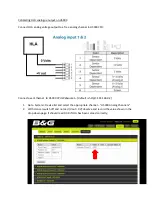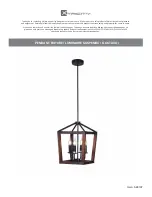
the fixture will respond to values corresponding with the number of channels that the fixture is occupying.
(For example, when you set the starting address to value 003, the fixture will respond to channels 3, 4, 5
etc.)
Channel mode:
The channel mode of the fixture makes it possible to use the correct channel mode setting
for every application. For simple and basic setups, users may prefer to use the 11 CH mode. For advanced
setups, users may prefer to choose the 15CH mode to be able to control the colour of every pixel.
Show mode:
Select one of the 4 built-in shows for the music controlled mode. Please note that the Sound
State needs to be activated for this function to be used effectively.
AutoRun mode:
Select one of the 4 built-in shows and select a speed for the show to operate on. The user
can choose from speeds 1 through 9, where 1 is slow and 9 is fast. During low speed operation, movements
will change as fluidly as possible.
Slave mode:
Select the right operation for the fixture. The most common mode is the master mode. If you
select Slave mode 1 or 2 (2 is partially reversed in music controlled mode), the fixture only listens to a signal
provided by the master fixture.
To use the master-slave mode, connect two ERO 706 fixtures together with standard 3P XLR male – 3P XLR
female cable (not included). Connect the DMX output of the master to the DMX input of the slave function.
Regardless of the mode selected on the master fixture (AutoRun, Sound controlled), the slave will mimic the
actions.
It is possible to invert the pan or tilt value of the slave, which makes wonderful synchronized or mirrored
performances possible without having to use a controller.
NOTE:
Please note that it is not possible to switch to any working mode if the Slave mode is active on your
fixture!
Black out:
Choose what the fixture will do during DMX signal loss. For theatrical applications, most users
choose to let the fixture switch to Black out, where all values are set to 0 and there is no light output until the
signal comes back.
For disco applications, most users might want to activate the last chosen mode if the last signal is lost. This
can be the AutoRun mode or the music controlled mode.
Sound state:
The sound state shows whether the unit's built-in microphone is active or not. It can be enabled
or disabled in the menu.
Sound sense:
The sensitivity of the built-in microphone is adjustable, in order to optimise the built-in sound-
controlled mode. For example, when your music source (speakers) is placed far away, it is possible to
increase the sensitivity to make sure that the fixture responds to the sound accurately.
White balance:
Colour balance. For theatrical applications, users may want to change the colour balance of
the bar so it is more similar to the colours of other lighting fixtures. With this mode, the maximum intensity for
each basic colour (red, green, blue) can be limited from values 50 to 255. When this mode is selected, use
the up and down buttons to scroll between the basic colours, and press enter to see the current values.
Adjust values with the up and down buttons and press enter to store changes. The default setting is 255 for
each basic colour.
Backlight:
LED display on/off. When using this device in a club or theatre, the environment is mostly dark.
Therefore, it is possible to shut off the LED menu display when it is not in use. the default setting is ON, which
means that the LED display remains on all the time.
Auto test:
When this mode is selected, the unit will perform pan and tilt movements to test the stepping
motors. After this, the LEDs are tested to see if there are any broken LEDs. The process continues until the
process is disabled manually via the menu display.
Temp check:
Check the temperature of the fixture to see if anything is wrong or if you are interested in the
All information and illustrations shown in this user manual are subject to change without further notice.
User manual version: 1.0
Creation date + author initials: 13-05-2015 RV Revision date + author initials:



































